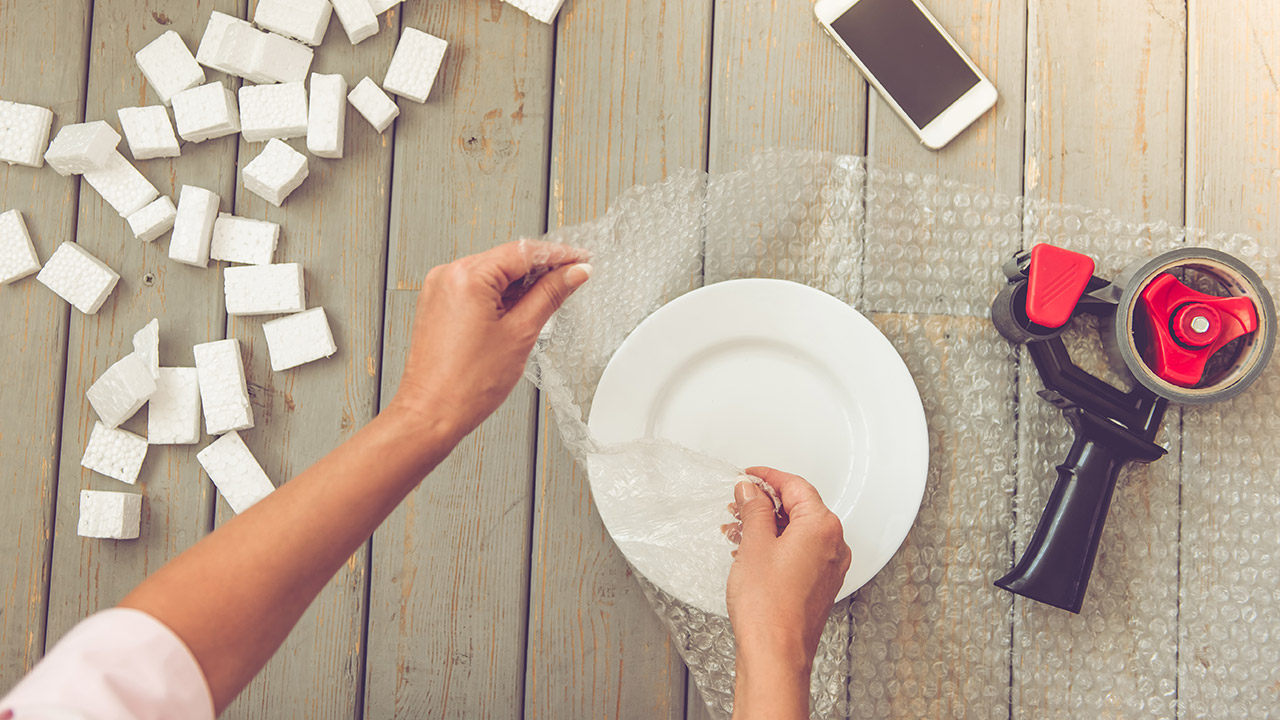
The odds of your most fragile belongings suffering damage during a big move are pretty high if the necessary precautions aren’t taken into consideration. It’s vital that you take the time to properly package and label your delicate items in order to make sure that they arrive to their final destination in one piece.
The best thing you can do while packing is take your time. When you’re strapped for time and have to rush to get everything packed away and ready to be moved, that’s when problems arise. Instead, plan ahead and give yourself plenty of time to properly pack up your delicates while keeping the following tips in mind.
1. Gather Up Your Arsenal of Packing Materials
Packing delicates is not exactly like packing your average product. You need specific types of packing material that will ensure that your fragile goods are adequately wrapped and kept safe from damage.
One of the most important steps for safely packing very delicate items is gathering the appropriate packing supplies. Last Sunday’s newspaper and the box that your toaster came in won’t cut it. When it comes to packing easily-breakable items for a big move, you’ll need the following supplies:
• Sturdy cardboard boxes – The type of cardboard boxes that you need should be very thick and strong so that the weight of your items isn’t too much for them to withstand;
• Bubble wrap – Nothing beats the amount of protection that bubble wrap can provide, so be sure to stock up on a few rolls;
• Packing paper – You’ll need plenty of packing paper to stuff in between items to make sure they stay put and don’t move around the their boxes. And you can forget about printed newspaper – this stuff will just leave marks all over your items;
• Packing tape – The higher the quality, the better, as strong packing tape will ensure your delicates won’t fall through the bottom of the boxes.
2. Make Sure the Moving Boxes Are Sturdy Enough to Handle the Weight
Preparing the boxes that you’ll be using is a crucial step, and is probably just as important as wrapping your fragile items. You want them to be strong enough to hold the weight of your goods while also providing some cushioning at the same time.
To make sure the moving boxes are fully capable of handling these potentially heavy loads, look closely at them to make sure there is no structural damage. Tape up all openings of the boxes – especially on the bottom – to give them some extra strength. Line the bottom of the boxes with crumpled packing paper to help eliminate any vibrations or impact that could damage your items.
3. Wrap and Pack Each Type of Item Appropriately
Not every type of delicate item should be packed the same way:
Plates – Each plate should be individually wrapped in bubble wrap and then packed vertically, the way vinyl records are stacked. Storing them in this manner can help cut back on the risk of breakage during the move. Take things a step further and add a sheet of pliable cardboard or foam between each plate and on the top and bottom of your box, again stacking them vertically.
Glasses – Wrap each glass with packing paper, making sure to tuck some of it inside as well. Considering how delicate these items are, it’s recommended to pack them in small boxes in order keep the weight to a minimum. You can layer the glasses on top of each other, but just make sure to place the heavier glasses at the bottom and not layer too much. Divide each layer with a sheet of cardboard or foam.
Glass and ceramic accessories – If you’ve got vases, bowls, or other fine glass and ceramic goods, use small boxes. Wrap each item in packing paper and fill in the middle with crumpled packing paper. Then, wrap the entire item in bubble wrap. The bottom of the box should be lined with thick padding, such as towels or linens, to absorb shock.
Mirrors, picture frames, and other large items – Before you wrap and pack large glass items like these, wrap painter’s tape around the width and length to form a “+”, which will help absorb any shocks that could possibly crack the glass. Place foam protectors on each corner, then wrap them in bubble wrap secured with tape.
4. Prevent Movement of Your Delicates Within Their Boxes
After you’ve wrapped and packed your delicates into their appropriate boxes, fill up every tiny space with crumpled packing paper. This will help to prevent any shifting of your delicates while they’re being hauled to your new home. You can even use socks, towels, scrap pieces of bubble wrap, or anything else small enough that will be able to keep your goods in place so you find them in the same condition you left them in.
5. Clearly Label Your Boxes
This might sound like a no-brainer, but it’s amazing how easily you can forget such a seemingly simple task. Not only should you label the boxes “FRAGILE” on at least two sides of the boxes, you should also indicate which side is up. In addition, specify which items are in the boxes and what room they belong in to make unpacking a lot easier.
The Bottom Line
It goes without saying that once all of your delicate belongings have been packed up in their respective boxes, you need to take extra care when moving them. Watch every step you make, don’t rush, set the boxes down slowly and gently, and use ropes or straps to secure them in the back of your moving truck or trailer. If you’re driving the truck yourself, proceed cautiously. Practicing vigilance is the best way to pack and move your fragile items when transporting them to your new home.